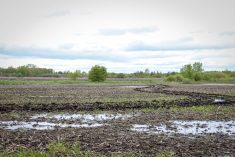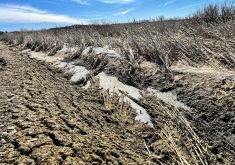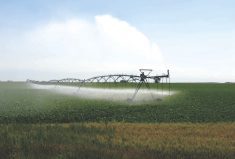[UPDATED: Sept. 14, 2021] Here’s some good news for Manitoba farmers about 2021 crop yields.
While down from 2020, Statistics Canada’s latest crop estimate puts some Manitoba yields above what many expected given this year’s significant drought.
The bad news is what farmers harvest in the end could be lower than the early estimates.
StatsCan released its production of principal field crops report, Aug. 30, providing a snapshot of expected Canadian yields as of the end of July.
“If the conditions (in August) continued to impact crops you could see a change in some of the yield estimates in that September (14, StatsCan) release,” John Seay, unit head of StatsCan’s Agriculture Division, Economic Statistics Field, said in an interview Aug. 31.
Why it matters: The driest and hottest growing season in years will cut Manitoba crop yields this year, but it’s possible, on average, improved plant genetics and agronomics, could result in better results than expected.
StatsCan’s yield estimates for Manitoba are much higher than those for Saskatchewan and Alberta (see table below). For example, StatsCan puts spring wheat in Manitoba at 56 bushels an acre compared to 32 and 35 in Saskatchewan and Alberta, respectively. That’s a difference of more than 20 bushels an acre.

“Something doesn’t seem right with the Manitoba (wheat) number,” MarketsFarm analyst Mike Jubinville said in an interview Aug. 31. (Glacier FarmMedia owns MarketsFarm and the Manitoba Co-operator)
However, there are anecdotal reports of some Manitoba wheat yields being better than expected.
[VIDEO (below): Manitoba Co-operator editor Gord Gilmour on the accuracy of satellite crop estimates]
Traditionally StatsCan made yield estimates based solely on farmer surveys, but for a number of years it has been developing a system using remote sensing, satellite images, and computer models. That’s how the July estimates were made.
Jubinville wonders if the technology is accurate enough.
Manitoba Agriculture and Resource Development oilseed specialist Dane Froese has the same question, especially during a severe drought.
“It’s really coming to light, more so this week, that crop biomass is not an indicator of yield production this year,” Froese said in an interview Aug. 31. “It’s very obvious, particularly in oats and canola. We are not seeing the same level of response we normally do… where more biomass means more yield at the end of the day… ”
“The heat blast and heat stress has been insane on many canola crops. It has been tough on many cereal crops. On soybeans and dry beans too many flowers were aborted and lost so the vegetative matter is there but it wasn’t throwing the pods that correspond to that level of vegetative growth. We’ve seeing farmers go through thick spots in fields and the canola should be yielding 40 (bushels an acre) and they might be getting 15 in some instances. Satellite images are going to pick up vegetative growth more so than seed growth or pod growth and as a result will lead to overestimation.”
The accuracy of StatsCan’s July estimates will be clearer when it releases its November report Dec. 3, which includes yield data collected from farmers, Seay said.
StatsCan will release another crop production report based on August conditions, also using remote sensing, Sept. 14.
However, StatsCan has confidence in its estimates based on remote sensing, he added.
“The decision to move towards using the model in place of the traditional survey in July was based on quantitive research done within Statistics Canada,” Seay said. “And the result of that research showed that, in general, the model tends to produce estimates that are as good or better relative to the final estimates in November than what the survey did. So we do have confidence in the method and we have confidence not only on an average or good year. The model goes back at least 20 years so it has seen years like this before like in 2002. Again we feel pretty confident the model is doing a good job.”
Statistics Canada has used satellite technology to model preliminary crop yields and production since 2016 and started using it in its July yield estimates beginning in 2020.
From a Prairie-wide perspective the latest StatsCan report is within grain trade expectations, Jubinville said.
“But considering stressful (growing) conditions continued into August my expectation is that… a good portion of these commodities will see a continued deterioration (in yield) to some degree,” he said. “The wheat (in Manitoba) may (pleasantly) surprise us in some respects.”
Of Manitoba’s major crops, StatsCan says soybeans will take the biggest percentage drop in yield from last year down 39 per cent to an average of 22.7 bushels an acre.
That’s not surprising. Experts say soybeans need rain in late July or early August to yield well. The recent August rains came too late, but are expected to plump up seeds.
The Manitoba Co-operator looked at StatsCan’s estimates for spring wheat, canola, soybeans, grain corn, barley, oats and sunflowers in Manitoba. StatsCan estimated yields for all of them will be lower than last year. However, its spring wheat (56.3 bushels an acre) and sunflower (1,950 pounds an acre) estimates are higher than the 10-year average crop insurance yield, by 4.2 and 24 per cent, respectively.

Remember, StatsCan’s estimate is based on crop conditions at the end of July and yields could be lower by the time crops are in the bin.
When StatsCan’s yield estimates are compared against 80 per cent of the crop insurance 10-year average, only soybeans would trigger a crop insurance payment.
This analysis is based on ‘averages’ and whether individual farmers trigger insurance payouts depends on their own yields and coverage.
While the early yield estimates are higher for Manitoba, Prairie-wide the decline in yields and production is dramatic.
StatsCan says Canadian all-wheat production is projected to fall 34.8 per cent to 22.9 million tonnes. Drought is a major factor, but spring wheat acres are also down in the West.
Canadian canola production is expected to drop 24.3 per cent to 14.7 million tonnes. If StatsCan is accurate it will be the lowest canola production since 2012.
Canola yields are projected to be the lowest in a decade offsetting higher harvested area, up an estimated eight per cent to 22.2 million acres.
“I still feel there is a herculean task that faces Canadian agriculture in trying to match what is going to be a very limited (grain) supply,” Jubinville said. “It seems rare that I’ve seen… record tight ending stock prospects amongst all of the commodities.
“I suspect we’re going to see very strong prices if not record prices throughout this marketing year just because our Canadian situation is extraordinarily tight. But there are certainly lots of questions on the global stage as well that could generate even more upward momentum.”
However, while Canadian crop prices are expected to stay high, world markets could see Canadian prices decline, but likely remain at a premium to world prices to ration demand for Canadian crops, he said.
*Update: A graphic indicating estimated barley yield in Manitoba was updated.
For more content related to drought management visit The Dry Times, where you can find a collection of stories from our family of publications as well as links to external resources to support your decisions through these difficult times.





















